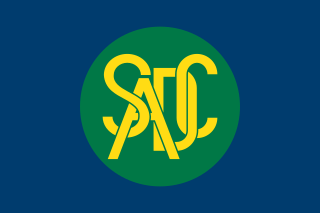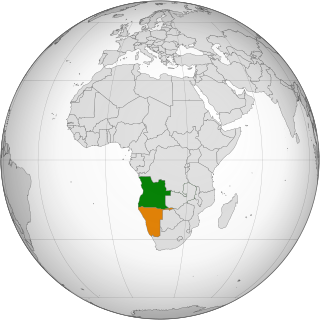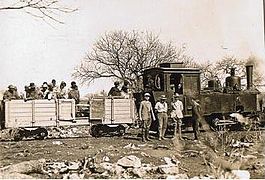
The economy of Botswana is currently one of the world's fastest growing economies, averaging about 5% per annum over the past decade. Growth in private sector employment averaged about 10% per annum during the first 30 years of the country's independence. After a period of stagnation at the turn of the 21st century, Botswana's economy registered strong levels of growth, with GDP growth exceeding 6–7% targets. Botswana has been praised by the African Development Bank for sustaining one of the world's longest economic booms. Economic growth since the late 1960s has been on par with some of Asia's largest economies. The government has consistently maintained budget surpluses and has extensive foreign-exchange reserves.

Namibia, officially the Republic of Namibia, is a country in Southern Africa. Its western border is the Atlantic Ocean. It shares land borders with Zambia and Angola to the north, Botswana to the east and South Africa to the south and east. Although it does not border Zimbabwe, less than 200 metres of the Botswanan right bank of the Zambezi River separates the two countries. Its capital and largest city is Windhoek.

At 824,292 km2 (318,261 sq mi), Namibia is the world's thirty-fourth largest country. After Mongolia, Namibia is the second least densely populated country in the world. Namibia got its name from the Namib desert that stretches along the coast of the Atlantic. It is also known for its wildlife.
This article deals with the system of transport in Namibia, both public and private.

The Caprivi Strip, also known simply as Caprivi, is a geographic salient protruding from the northeastern corner of Namibia. It is bordered by Botswana to the south and Angola and Zambia to the north. Namibia, Botswana and Zambia meet at a single point at the eastern tip of the Strip, which also comes within 150 m (490 ft) of Zimbabwe thus nearly forming a quadripoint.

Southern Africa is the southernmost region of Africa. No definition is agreed upon, but some groupings include the United Nations geoscheme, the intergovernmental Southern African Development Community, and the physical geography definition based on the physical characteristics of the land.

The Southern African Development Community (SADC) is an inter-governmental organization headquartered in Gaborone, Botswana.

The Southern Africa-Indian Ocean Division (SID) of Seventh-day Adventists is a sub-entity of the General Conference of Seventh-day Adventists, which coordinates the Church's activities in the southern portion of Africa, which include the nations of Angola, Ascension Island, Botswana, Comoro Islands, Lesotho, Madagascar, Malawi, Mauritius, Mozambique, Namibia, Réunion, São Tomé and Príncipe, Seychelles, South Africa, Swaziland, Zambia, Zimbabwe; as well as St. Helena and Tristan da Cunha, territories of the United Kingdom, and the Kerguelen Islands, territory of France. Its headquarters is in Centurion, South Africa. The Division membership as of June 30, 2021 is 4,281,416.

The Frontline States (FLS) were a loose coalition of African countries from the 1960s to the early 1990s committed to ending apartheid and white minority rule in South Africa and Rhodesia. The FLS included Angola, Botswana, Lesotho, Mozambique, Tanzania, Zambia, and Zimbabwe. The FLS disbanded after Nelson Mandela became President of South Africa in 1994.

The Caprivi conflict was an armed conflict between the Namibian government and the Caprivi Liberation Army, a rebel group that waged a brief insurrection in 1999 for the secession of the Caprivi Strip.

The following outline is provided as an overview of and topical guide to Botswana:

The following outline is provided as an overview of and topical guide to Namibia:

Namibia–South Africa relations refers to the current and historical relationship between Namibia and South Africa. South Africa captured the area now known as Namibia from Germany during World War I and governed it, by the name 'South West Africa', until 1990, when the country gained independence under the name 'Namibia'. During those 75 years, thousands of South Africans settled in the territory and South Africa treated the area as effectively a fifth province of both the Union and the Republic, imposing apartheid laws in South West Africa as it did in South Africa.

Angolan–Namibian relations relate to the relations between the governments of the Republic of Angola and the Republic of Namibia.

Botswana–Namibia relations refers to the current and historical relationship between Botswana and Namibia. As of 2009, relations were considered friendly, with the two neighboring countries cooperating on economic development. Botswana gained independence from Britain in September 1966. Namibia gained independence from South Africa in 1990 following the Namibian War of Independence, and the two countries soon after established formal diplomatic relations. Botswana has a high commission in Windhoek. Namibia has a high commission in Gaborone.
Cavmont Bank Limited is a commercial bank in Zambia. It is licensed by the Bank of Zambia, the central bank and national banking regulator.

Rail service in Namibia is provided by TransNamib. The Namibian rail network consists of 2,687 route-km of tracks (2017).

Namibia is an arid country that is regularly afflicted by droughts. Large rivers flow only along its northern and southern borders, but they are far from the population centers. They are also far from the country's mines, which are large water users. In order to confront this challenge, the country has built dams to capture the flow from ephemeral rivers, constructed pipelines to transport water over large distances, pioneered potable water reuse in its capital Windhoek located in the central part of Namibia, and built Sub-Saharan Africa's first large seawater desalination plant to supply a uranium mine and the city of Swakopmund with water. A large scheme to bring water from the Okavango River in the North to Windhoek, the Eastern National Water Carrier, was only partially completed during the 1980s.

The 2016 COSAFA Cup was the 16th edition of the COSAFA Cup, an international football competition consisting of national teams of member nations of the Council of Southern Africa Football Associations (COSAFA). Originally, it was to be held in Windhoek, Namibia during May 2016, however the tournament was rescheduled to avoid a clash with the South African Premier Soccer League and took place in June 2016.


















